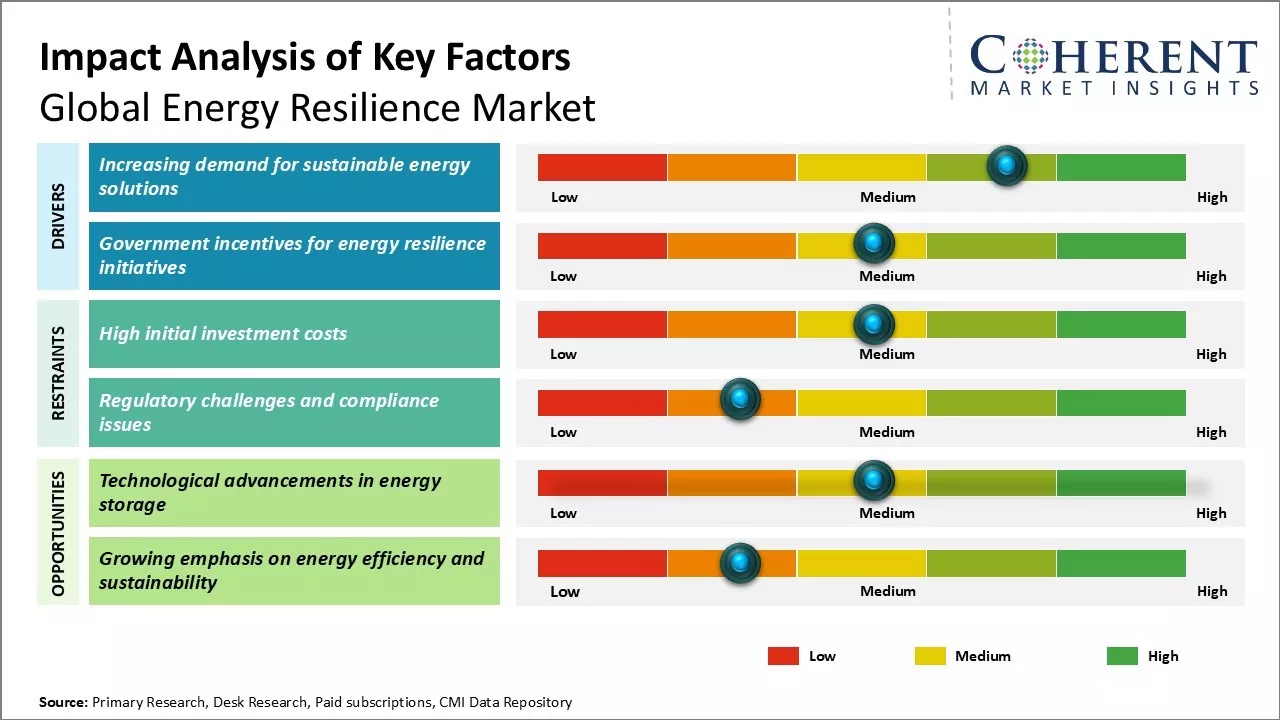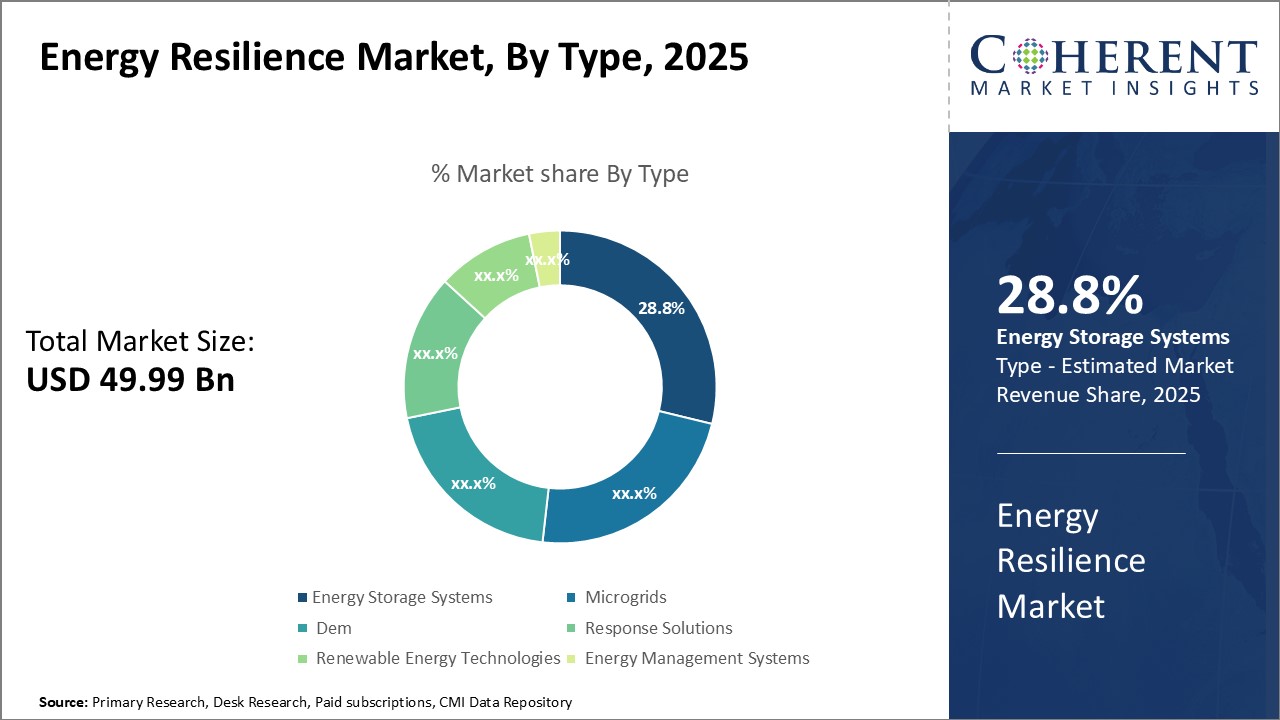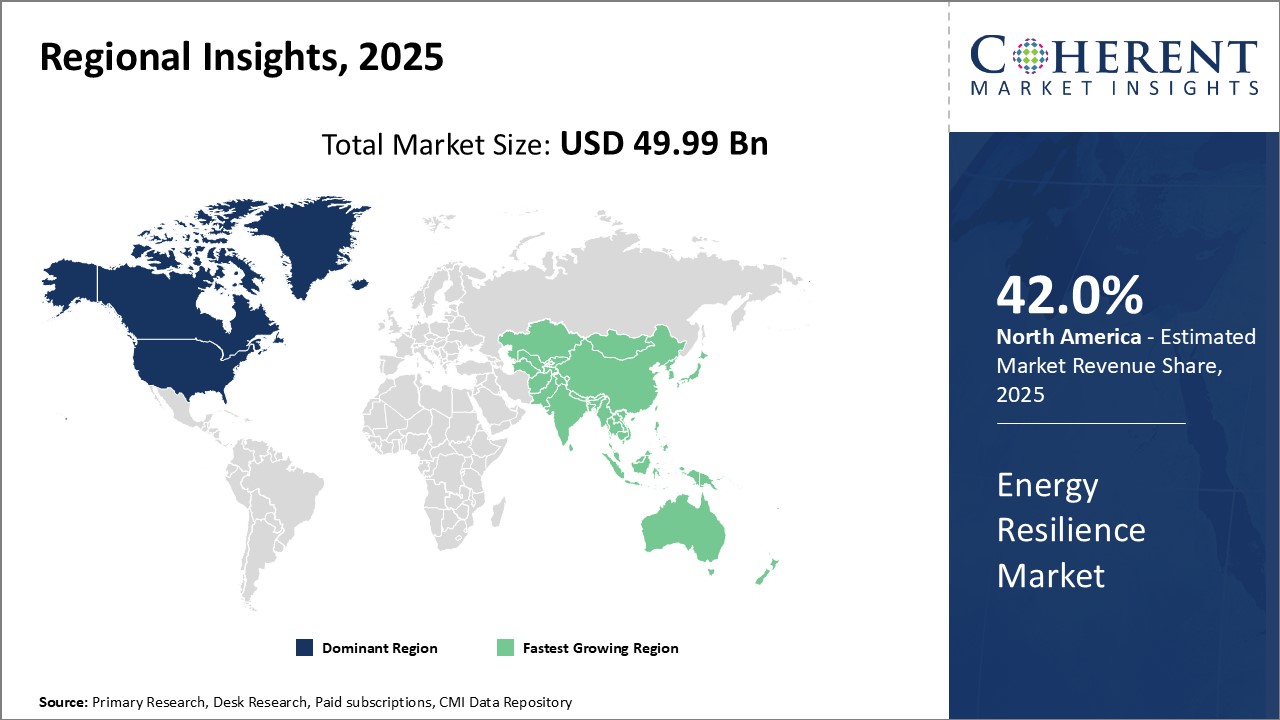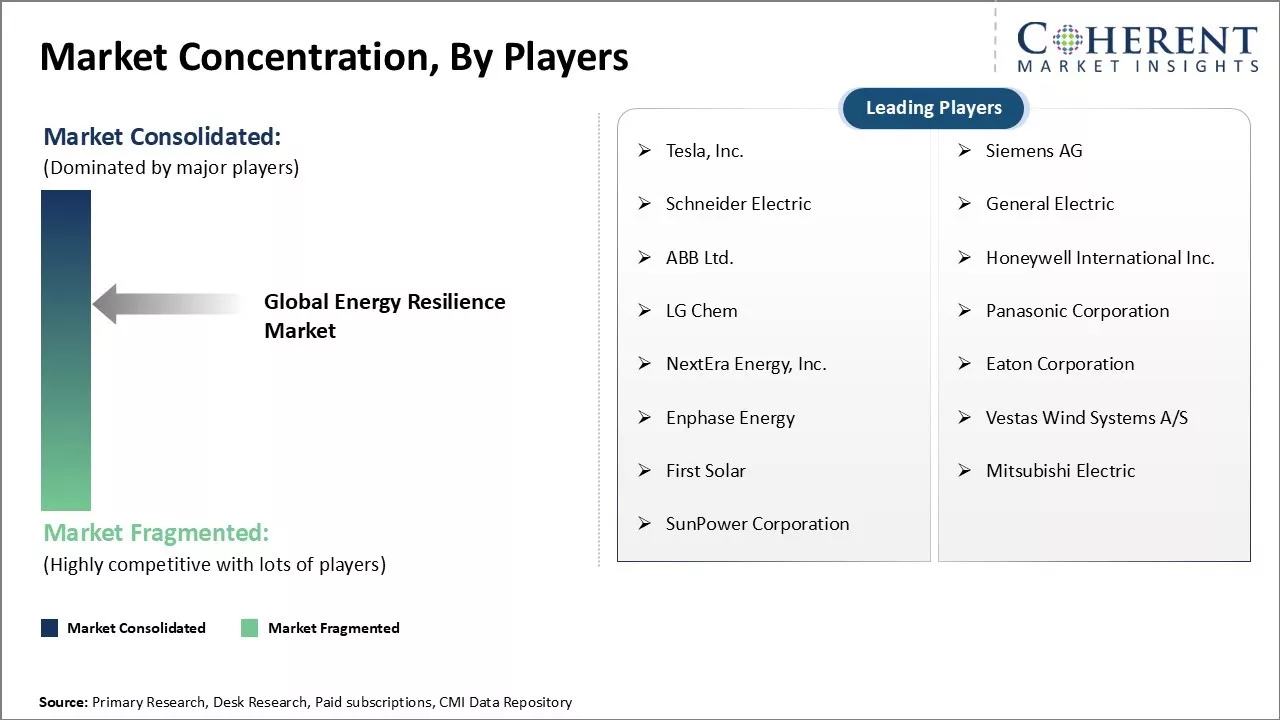Energy Resilience Market Size and Trends
Global energy resilience market is estimated to be valued at USD 49.99 Bn in 2025 and is expected to reach USD 95.64 Bn by 2032, exhibiting a compound annual growth rate (CAGR) of 9.7% from 2025 to 2032.

Discover market dynamics shaping the industry: Download Free Sample
Widespread power outages due to extreme weather events and increasing number of cyber-attacks on critical infrastructure have pushed many commercial and industrial facilities to invest in energy resilience solutions to ensure business continuity. The market growth is driven by rising need for uninterrupted power supply among various end-use industries. Rising emphasis on building smart and sustainable infrastructure also boosts demand for energy storage and microgrid solutions.

Discover high revenue pocket segments and roadmap to it: Download Free Sample
Insights By Type- Energy Storage Systems Leads in Reshaping Energy Infrastructure
In terms of type, energy storage systems segment is estimated to contribute the highest market share of 28.8% in 2025, owing to their ability to store electricity from renewable sources for later use. Energy storage addresses renewable energy intermittency by storing excess power during high generation periods for later use, enhancing grid reliability. Batteries, particularly lithium-ion, dominates due to their versatility and scalability, enabling higher renewable energy integration without compromising system stability or reliability.
Insights By Application- Residential Segment Leads Energy Resilience Demand
In terms of application, residential segment is estimated to contribute 25.8% share of the global energy resilience market in 2025, owing to growing consumer demand for reliable and affordable home power solutions. Extreme weather events are increasingly disrupting electric grids, highlighting the need for residential backup power. Consumers also seek more control over energy usage and costs through self-generation and storage. Distributed solar PV systems combined with batteries are gaining popularity in residential sectors due to incentives for sustainability and long-term savings.
Regional Insights

Need a Different Region or Segment? Download Free Sample
Dominating Region- North America
North America is expected to dominate the energy resilience market in 2025, with an estimated market share of 42.0%. Countries in the region have witnessed severe natural calamities in the past, thus, highlighting the need for energy security. Moreover, strong presence of global players and established industrial and commercial sectors boosts demand for uninterrupted power supply solutions.
Fastest-Growing Region- Asia Pacific
Asia Pacific exhibits the fastest growth, led by countries like China, India, and Japan. Rapid urbanization and industrialization have increased the burden on conventional power grids in these emerging economies. This encourages investments in distributed energy resources and smart microgrid technologies for both rural and urban applications. Supportive government initiatives such as global environment facility to strengthen energy access further stimulate market opportunities.
Energy Resilience Market Outlook for Key Countries
Modernizing the U.S. Power Grid- Investments in Resilience, Storage, and Advanced Technologies for a Secure Energy Future
The U.S. market is characterized by frequent power outages due to extreme weather events. Leading companies such as Tesla Inc. are heavily investing in innovative storage solutions and microgrid controls to modernize the country's aging grid infrastructure. Utilities are investing in advanced technologies to enhance grid reliability and integrate distributed energy resources. The U.S. has significantly invested in 2023 in modernizing its power grid, with an emphasis on advanced grid technologies, storage solutions, and improving energy security, particularly in disaster-prone areas like California and Texas.
China's Energy Transformation- Advancing Clean Distributed Generation and Smart Grid Investments for a Resilient Future
China’s energy resilience market prioritizes clean distributed generation to meet rising energy demand from its manufacturing industries and facilitate rural electrification. Domestic manufacturers such as NextEra Energy, Inc. are strengthening their portfolios to capitalize on the country's ‘New Energy' mission. In 2023, China announced ambitious plans to enhance its energy resilience through increased investment in smart grid and renewable energy projects.
India's Renewable Energy Push- Advancing Grid Stability and Resilience Through Energy Storage and Infrastructure Development
India continues to lead the renewable energy deployment globally. Due to intermittent renewable supply, energy storage plays a critical role in ensuring grid stability and reliability of power supply across urban and rural areas. In 2023, India launched several programs such as Rural Electrification and Energy Access aimed at enhancing energy resilience, particularly in rural areas. The government pushes greater adoption of solar and wind energy, alongside improving grid infrastructure.
Japan's Path to Energy Resilience- Strategic Partnerships, Hydrogen Innovation, and Nuclear Expansion
Japan’s market focuses on strategic partnerships with global providers to strengthen energy security on its island territories vulnerable to natural disasters. The country is an early adopter of cutting-edge technologies like hydrogen fuel cells. For instance, according to Atlantic Council Data in August 2025, Japan plans to increase its nuclear energy capacity to 11.5% by 2030 from 4.5% in 2019, with nuclear being a critical part of its strategy to ensure energy resilience.
Market Concentration and Competitive Landscape

Get actionable strategies to beat competition: Download Free Sample
Top Strategies Followed by Global Energy Resilience Market Players
Established Players
- R&D Investment- Leading companies such as LG dedicate over 5% of their annual revenues to research and development in order to develop advanced energy storage solutions. These focus on lithium-ion and solid-state batteries with higher energy density and efficiency.
- Strategic Partnerships- Major players strategically partner with OEMs to capitalize on their distribution networks and manufacturing capabilities globally. For example, Tesla partnered with Panasonic for battery cell production in 2023.
Mid-Level Players
- Cost-Effective Solutions- Mid-level companies cater to price-conscious small businesses and households. These develop no-frills products with competitive pricing through efficient operations and mass production. For example, Duracell power banks are priced at US$ 20-50.
Small-Scale Players
- Niche Specialization- Such companies focus on specialized segments like customized energy storage for EV charging stations, solar+storage, medical devices, and others, thus, offering tailored features
- Tech Adoption- First Solar leverages the latest IoT, AI, and Cloud technologies to manage energy assets remotely and offer pay-per-use models for new revenue streams
Emerging Startups in the Industry
Innovative Technologies-
- Examples- Startups like Ambri, Form Energy and SPARKZ develops long-duration batteries based on liquid metal and calcium technologies with weeks of storage
- Market/Impact- Adoption of these technologies can enable widespread integration of renewable energy and stabilize grids
Sustainable Solutions
- Examples- Companies like Redflow and Liquid Light are commercializing zinc-bromine and perovskite solar flow batteries with upcycled materials
- Environmental Impact- Their solutions help reduce dependence on rare-earth materials and accelerate transition to greener energy models
- Startups are making significant inroads into specialized sectors by developing tailored solutions for cutting-edge applications. These include providing energy access in off-grid rural areas, advancing the electrification of aircraft, and pioneering the deployment of electric ferries. Through customized innovations, these address specific challenges and enable sustainable development in these frontier markets.
Energy Resilience Industry News
Operational Insights
- Siemens AG has been integrating digital technologies into energy infrastructure, enabling smarter grid management and real-time monitoring. This enhances the resilience of energy systems by optimizing energy distribution and reducing outages. The company has been investing in projects that facilitate the integration of renewable energy sources into existing grids. This includes wind, solar, and hydroelectric power, which contribute to a more sustainable and resilient energy mix. The company’s microgrid solutions allow communities and businesses to operate independently from the main grid. This technology is especially valuable in remote areas or regions prone to natural disasters.
Key Takeaways from Analyst
- Increasing frequency and severity of power outages due to extreme weather events as well as rising concerns over climate security can drive the market growth. Growing focus on decreasing dependence on centralized power grids through distributed energy resources can also aid the market expansion. High initial capital costs associated with energy resilience solutions might limit adoption, especially in developing markets.
- North America region currently dominates the global energy resilience market and is anticipated to continue its dominance. Rapid industrialization and urbanization along with growing energy needs of evolving economies in the region boosts the demand. Asia Pacific also presents substantial opportunities due to frequent power outages affecting critical infrastructures and increasing initiatives to modernize aging power infrastructure. The markets in Asia Pacific can witness growth at an impressive pace due to policy push for decentralized renewable energy-based microgrids.
Market Report Scope
Energy Resilience Market Report Coverage
| Report Coverage | Details | ||
|---|---|---|---|
| Base Year: | 2024 | Market Size in 2025: | USD 49.99 Bn |
| Historical Data for: | 2020 To 2024 | Forecast Period: | 2025 To 2032 |
| Forecast Period 2025 to 2032 CAGR: | 9.7% | 2032 Value Projection: | USD 95.64 Bn |
| Geographies covered: |
|
||
| Segments covered: |
|
||
| Companies covered: |
Tesla, Inc., Siemens AG, Schneider Electric, General Electric, ABB Ltd., Honeywell International Inc., LG Chem, Panasonic Corporation, NextEra Energy, Inc., Eaton Corporation, Enphase Energy, Vestas Wind Systems A/S, First Solar, Mitsubishi Electric, and SunPower Corporation |
||
| Growth Drivers: |
|
||
| Restraints & Challenges: |
|
||
Uncover macros and micros vetted on 75+ parameters: Get instant access to report
Market Dynamics
Market Driver- Increasing demand for sustainable energy solutions
Growing concerns about environmental degradation and climate change from fossil fuel reliance have spurred governments to promote distributed renewable energy through net metering policies and rooftop solar schemes. According to the International Energy Agency (IEA) in 2022, over 25 million households globally now use rooftop or community solar systems. Large corporations and industrial entities are increasingly adopting renewable technologies like solar panels, wind turbines, hydropower, and energy storage for energy resilience.
Market Challenge- High initial investment costs
Key challenges faced by the global energy resilience market includes high initial investment costs associated with setting up energy storage and backup systems. These heavy initial costs put severe financial constraints on consumers, businesses, industrial facilities and policymakers that want to transition to cleaner and distributed sources of energy but have limited capital. According to data by International Energy Agency, in 2020, nearly 75% of electricity generation projects globally were cancelled or delayed due to lack of funding amid pandemic recession.
Market Opportunity- Technological advancements in energy storage
Major opportunities for this market include ongoing technological advancements in the field of energy storage. Lithium-ion battery costs have declined sharply over the past decade due to scaling up of production and continuous R&D enabling higher energy densities. Battery technology in particular has progressed significantly in recent years, driving down costs and improving performance of energy storage solutions for applications ranging from residential to utility-scale. According to the International Renewable Energy Agency (IRENA), global battery energy storage deployments grew 85% from 2020 to 2021, reaching a total capacity of 21 GW in 2021.
Market Segmentation
- Type Insights (Revenue, USD Bn, 2020 - 2032)
-
- Energy Storage Systems
- Microgrids
- Demand Response Solutions
- Renewable Energy Technologies
- Energy Management Systems
- Application Insights (Revenue, USD Bn, 2020 - 2032)
-
- Residential
- Commercial
- Industrial
- Utilities
- Regional Insights (Revenue, USD Bn, 2020 - 2032)
- North America
- U.S.
- Canada
- Latin America
- Brazil
- Argentina
- Mexico
- Rest of Latin America
- Europe
- Germany
- U.K.
- Spain
- France
- Italy
- Russia
- Rest of Europe
- Asia Pacific
- China
- India
- Japan
- Australia
- South Korea
- ASEAN
- Rest of Asia Pacific
- Middle East
- GCC Countries
- Israel
- Rest of Middle East
- Africa
- South Africa
- North Africa
- Central Africa
- North America
- Key Players Insights
- Tesla, Inc.
- Siemens AG
- Schneider Electric
- General Electric
- ABB Ltd.
- Honeywell International Inc.
- LG Chem
- Panasonic Corporation
- NextEra Energy, Inc.
- Eaton Corporation
- Enphase Energy
- Vestas Wind Systems A/S
- First Solar
- Mitsubishi Electric
- SunPower Corporation
Share
Share
About Author
Yash Doshi is a Senior Management Consultant. He has 12+ years of experience in conducting research and handling consulting projects across verticals in APAC, EMEA, and the Americas.
He brings strong acumen in helping chemical companies navigate complex challenges and identify growth opportunities. He has deep expertise across the chemicals value chain, including commodity, specialty and fine chemicals, plastics and polymers, and petrochemicals. Yash is a sought-after speaker at industry conferences and contributes to various publications on topics related commodity, specialty and fine chemicals, plastics and polymers, and petrochemicals.
Missing comfort of reading report in your local language? Find your preferred language :
Transform your Strategy with Exclusive Trending Reports :
Frequently Asked Questions
EXISTING CLIENTELE
Joining thousands of companies around the world committed to making the Excellent Business Solutions.
View All Our Clients
